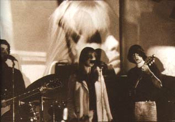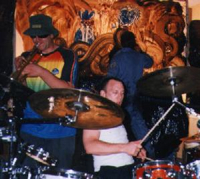Jefferson Airplane and Ken Kesey’s Merry Pranksters may have invented the acid test, but after a while, black lights, fluorescent paint, and ink swirling between the sheets of an overhead projector – as trippy as they were – had to pull up a beanbag and make way for the integration of the greater pop culture.
 There’s a long history to the art of film – or film collage – being played behind live performances. Ghost images of Nico and other band members flashed behind the Velvet Underground at the happenings of Warhol’s Exploding Plastic Inevitable. In Clint Eastwood’s 1968 “Coogan’s Bluff,” Clint visits a New York disco where half-nekkid go-go dancers cavort with a band playing in front of projected films. The Stones and early Pink Floyd were known to perform in front of films in 1960s London clubs.
There’s a long history to the art of film – or film collage – being played behind live performances. Ghost images of Nico and other band members flashed behind the Velvet Underground at the happenings of Warhol’s Exploding Plastic Inevitable. In Clint Eastwood’s 1968 “Coogan’s Bluff,” Clint visits a New York disco where half-nekkid go-go dancers cavort with a band playing in front of projected films. The Stones and early Pink Floyd were known to perform in front of films in 1960s London clubs.
 These days (or more recently anyway), the Butthole Surfers blast a hole through concert-go’ers trips by projecting footage of penile reconstructive surgery behind their performances. And on a completely different, non-filmic but genetically related planet, Norton Wisdom paints ever-morphing hypo-allergenic stick men and swirly gigs live behind the intricate thud of Banyan (Janes Addiction’s Stephen Perkins, plus Nels Cline and ex-Minutemen Mike Watt).
These days (or more recently anyway), the Butthole Surfers blast a hole through concert-go’ers trips by projecting footage of penile reconstructive surgery behind their performances. And on a completely different, non-filmic but genetically related planet, Norton Wisdom paints ever-morphing hypo-allergenic stick men and swirly gigs live behind the intricate thud of Banyan (Janes Addiction’s Stephen Perkins, plus Nels Cline and ex-Minutemen Mike Watt).
Jump sideways a few years, to the mid-90s. “Post-rock” has risen to fill an unnamed void, and Boston’s quartet Cul de Sac (not to be confused with the Croatian improv group of the same name) are bringing the ghost of John Fahey together with Can, Faust, and the Velvet Underground, creating fascinating, pulsing instrumentals that go way beyond hybrid, into uncharted territory that belongs exclusively to New England. Film makers Scott Hamrah and Chris Fujiwara started assembling powerful collages of classic obscure film, 1970s TV advertisements, and found scraps into films specifically designed to play – much larger than life – behind the band, helping to make Cul de Sac performances the unforgettable performances they were. Nearly a decade later, at least one of those films – a piece made to accompany “Doldrums,” from Cul de Sac’s 1996 album China Gate, has made it to YouTube:
Seeing the piece again swept me back to Boston, Glenn Jones’ potato-masher guitar rig, and memories of a piece I wrote on Cul de Sac for the Utne Reader in 1996, shamelessly reprinted below, regardless how embarrassing.
————-
The Post-Rock Phenomenon
Reprinted from the Utne Reader, 1996
When modernity came to an end and folded back in on itself, rock sputtered out in an uninspired tailspin, leaving a trail of a thousand identical grunge bands to kick hairballs around in the garage. The past five years of tiresome, lo-fi grunge has unflaggingly rehashed punk’s once-definitive assault, but without conviction. In the wake of rock’s last gleaming, a handful of seekers forge something new where nothing new is possible. The only way to come to sensible grips with the alleged phenomenon of “post-rock” is to consider that it is to rock as post-modern is to modern.. Post-rock bails out on the world of rock and goes “stratmospheric,” leaving behind the posturing, the testosterone, and the formulae that defined pop/rock in all its forms for decades. In post-rock, the accreted layers of musical history form a substrate through which artists speak of the mysterious present. Remixology becomes more than a collage technique – it’s the lingua franca, the currency of all that is good after rock gives up its pathetic struggle to rebel (against what? The alternative has been subsumed by “the man.”)
And yet, trying to find a common musical thread running through the bands that comprise the genre is practically impossible. I tried linking them up by similarity of sound, but Tortoise, Labradford, Jessamine, Ui, Flying Saucer Attack, Mercury Rev, et al sound radically different from one another. While some – like Mercury Rev — are busy jamming on culture with tape decks and jangly guitars, others – like Tortoise – are fusing deep dub and earthy synthesizers. Magnog’s organicism supercharges the trees with walls of drifting distortion, Pram plays their old Neu! records underwater, and Labradford simply spaces out into ennui flatter than glass. All these bands seem to have in common is an emphasis on musical texture over melody and harmony, and a disdain for the language of grunge.
In the midst of it all, a humble Boston quartet called Cul de Sac (Robin Amos, electronics; Chris Fujiwara, bass, vocals; Glenn Jones, guitars, contraption; Jon Proudman, drums) transcends the milieu into which they’ve been lumped. Rather than tipping their hats back toward the legacy of glam rock, dub, or punk, Cul de Sac draw their reeling, often improvisatory lines and propulsive, tumbling, tympanic percussion more strongly from the “krautrock” scene of Europe in the early 70s. Cul de Sac have more in common with Can than with Sly and Robbie, and have listened to more Stockhausen than Mannheim Steamroller. Like a rocking Harry Partch, they invent and build some of their own instruments: the “contraption” is a 1940s Hawaiian lap-steel guitar mounted on a baby casket, stuffed with effects boxes and played, to most alarming effect, with kitchen utensils. The “Incantor” is a mercilessly re-wired Texas Instruments Speak and Math capable of “unpredictable and delightful” incantations, according to Jones. Their kinaesthetic stage presence includes a backdrop of original films, an arrangement which casts not so much the pyschedelia of Warhol’s Factory as the slightly disturbed, emotional air of a Godard film festival. The band crackles with smart, electrical confidence and unpretentious, articulate energy.
Cul de Sac is one of the few bands that can use electronics without sounding slick and digital, an artifact of the members’ spiritually overlapping but musically distinct tastes: of the hardscrabble surrealism of Captain Beefheart, the psychedelic blues of Hendrix, the organic folk virtuousity of guitarist John Fahey, and improvisors from across the entire jazz spectrum. While these influences are all buried in Cul de Sac’s music, the band is much more than a pastiche of its traces. They’re not a retro art-rock band as much as an arts foundation that’s unwittingly landed at the forefront of a movement that happens to be going by the name of post-rock. Ironically, the band seems almost disinterested in the phylum as such. “Post-rock is a critical category for the convenience of historians of the cultural present,” claims Fujiwara. While they claim great respect for the Village Voice’s Simon Reynolds (who is most oft-cited as the term’s progenitor and torch-bearer), Cul de Sac makes it clear that they’ll hang their hats on the nail of their music, not on the music industry’s category of the week.
Their most recent release, “China Gate,” testifies clearly to that. Building on the strength of 1992’s “ECIM” with several extra years of musical sophistication, this recording turns out to be a musical and engineering marvel. So much happens simultaneously, and yet a distinct voice emerges as belonging to this band alone, like a new genre is being formed before your ears from raw clay. The question is, is there a place for new genres after modernity has expired?